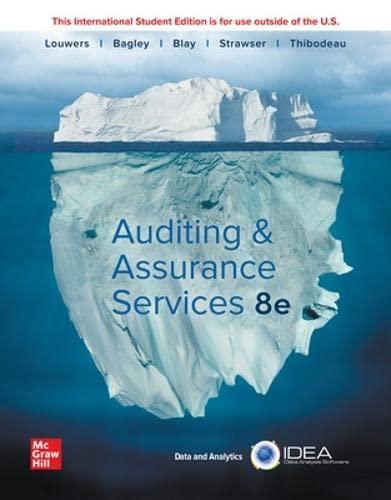Question
multiple-choice questions: a. Which of the following does the Financial Accounting Standards Board not issue? 1. SOPs 2. SFASs 3. Interpretations 4. Technical bulletins 5.
multiple-choice questions: a. Which of the following does the Financial Accounting Standards Board not issue? 1. SOPs 2. SFASs 3. Interpretations 4. Technical bulletins 5. SFACs
b. According to SFAC No. 6, assets can be defined by which of the following? 1. Probable future sacrifices of economic benefits arising from present obligations of a particular entity to transfer assets or provide services to other entities in the future as a result of past transactions or events 2. Probable future economic benefits obtained or controlled by a particular entity as a result of past transactions or events
3. Residual interest on the assets of an entity that remains after deducting its liabilities
4. Increases in equity of a particular business enterprise resulting from transfers to the enterprise
from other entities of something of value to obtain or increase ownership interests (or equity) in it 5. Decrease in equity of a particular business enterprise resulting from transferring assets, rendering services, or incurring liabilities by the enterprise
c. According to SFAC No. 6, expenses can be defined by which of the following? 1. Inflows or other enhancements of assets of an entity or settlements of its liabilities (or a combination of both) from delivering or producing goods, rendering services, or other activities that constitute the entitys ongoing major or central operations 2. Outflows or other consumption or using up of assets or incurrences of liabilities (or a combination of both) from delivering or producing goods, rendering services, or carrying out other activities that constitute the entitys ongoing major or central operations 3. Increases in equity (net assets) from peripheral or incidental transactions of an entity and from all other transactions and other events and circumstances affecting the entity during a period, except those that result from revenues or investments 4. Decreases in equity (net assets) from peripheral or incidental transactions of an entity and from all other transactions and other events and circumstances affecting the entity during a period, except those that result from expenses or distributions to owners 5. Probable future economic benefits obtained or controlled by a particular entity as a result of past transactions or events.
d. SFAC No. 5 indicates that an item, to be recognized, should meet four criteria, subject to the costbenefit constraint and the materiality threshold.Which of the following is not one of the four criteria? 1. The item fits one of the definitions of the elements. 2. The item has a relevant attribute measurable with sufficient reliability. 3. The information related to the item is relevant. 4. The information related to the item is reliable. 5. The item has comparability, including consistency.
e. SFAC No. 5 identifies five different measurement attributes currently used in practice. Which of the following is not one of the measurement attributes currently used in practice? 1. Historical cost 2. Future cost 3. Current market value 4. Net realizable value 5. Present, or discounted, value of future cash flows f. Which of the following indicates how revenue is usually recognized? 1. Point of sale 2. End of production 3. Receipt of cash 4. During production 5. Cost recovery
g. Statement of Financial Accounting Concepts No. 1, Objectives of Financial Reporting by Business Enterprises, includes all of the following objectives, except one. Which objective does it not include? 1. Financial accounting is designed to measure directly the value of a business enterprise. 2. Investors, creditors, and others may use reported earnings and information about the elements of financial statements in various ways to assess the prospects for cash flows. 3. The primary focus of financial reporting is information about earnings and its components. 4. Financial reporting should provide information that is useful to present and potential investors and creditors and other users in making rational investment, credit, and similar decisions. 5. The objectives are those of general-purpose external financial reporting by business enterprises.
The following data relate to Jones Company for the year ended December 31, 2009: Sales on credit $80,000 Cost of inventory sold on credit 65,000 Collections from customers 60,000 Purchase of inventory on credit 50,000 Payment for purchases 55,000 Cash collections for common stock 30,000 Dividends paid 10,000 Payment to salesclerk 10,000
Questions:
a. Determine income on an accrual basis. b. Determine income on a cash basis.
Step by Step Solution
There are 3 Steps involved in it
Step: 1

Get Instant Access to Expert-Tailored Solutions
See step-by-step solutions with expert insights and AI powered tools for academic success
Step: 2

Step: 3

Ace Your Homework with AI
Get the answers you need in no time with our AI-driven, step-by-step assistance
Get Started


